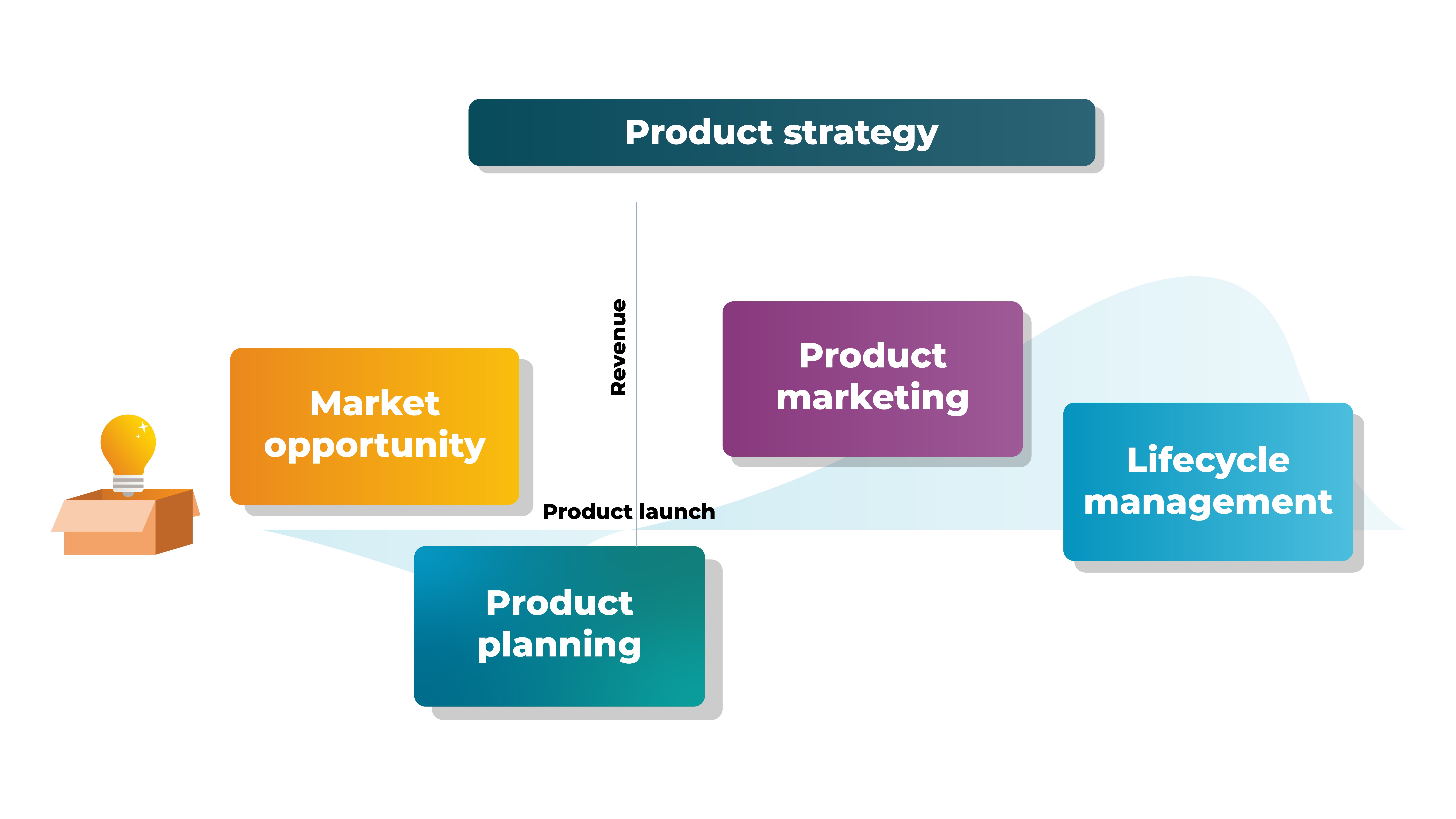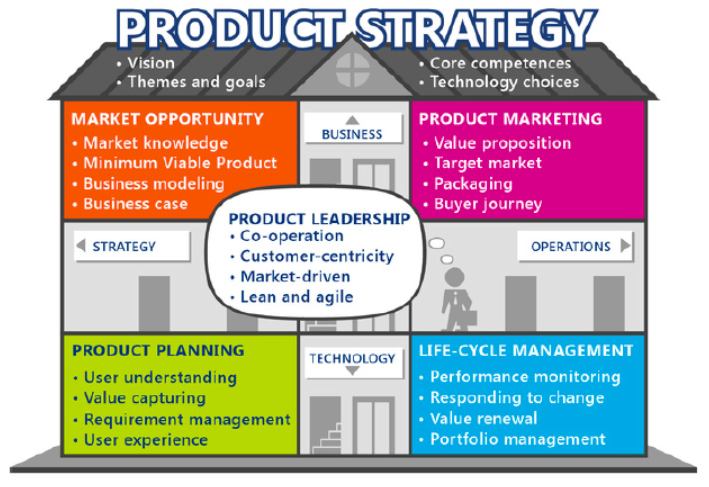A brief introduction to product management

You have a sense that product management is important. Because it is, to any company that offers productized solutions.
But for you to be even better able to support your company and your product successes, it is useful to know what exactly is involved in product management.
In this quick overview you will learn the most important things you need to know, to be a key part of your product organization, and the success of your solutions.
First of all: What is product management?
Product management is business-oriented product or service management. The goal is to maximize the benefits and the value your product or product portfolio generates throughout its product lifecycle.
The easiest way to understand product management is to look at the product lifecycle model and think about what kind of measures are needed at each stage. Unlike project management, product management is an ongoing activity, which from time to time also involves discontinuing the old and commercializing new ideas.
Product management is about taking care of the competitiveness of the company's products!
Here you can see the different product management aspects plotted into the product lifecycle:

Source: tuotejohtaminen.fi/en
The 5 key areas of product management
Product management encompasses many different areas that are all important to your product and business success. Let us have a look at the five most important areas in turn:
- Product strategy (which encompasses all the other areas)
- Market opportunity
- Product planning
- Product marketing
- Product lifecycle management
1. Product strategy - your direction for the future
The product strategy is the plan for how your product vision is realized - how your product goals are achieved.
To reach these goals, the entire product organization must have a common vision of what is desired and expected of the product. Typically, companies base this vision on quite abstract ideas, and numerical performance or growth targets.
A good product strategy is a concrete plan to develop and commercialize the product so that day-to-day tasks can be prioritized, and the organization maintains focus. The strategy should also be in line with other strategies, such as technology and market strategy, and the strategy of the company or business unit.
The product strategy points the way to the future and enables the goals to be achieved.
2. Market opportunity - from idea to innovation
A market opportunity is a screening of the best productization ideas. The concrete result of this can be, for example, a description of the business rationality for the estimated product idea, in the form of a business plan.
The most important areas for analyzing market opportunities are:
- market and customer understanding
- customer value validation
- business modeling
A market opportunity always involves uncertainties and assumptions. So to find the right opportunities, you should emphasize various tests, experiments, and continuous learning.
The lean startup movement has given us good models for analyzing the market opportunity. Growth companies use terms like: problem-solution fit and market-solution fit, i.e. finding the product that solves the problem and a large enough market for it. This is market opportunity mapping - a part of product management. This part of product management is emphasized in the growth business field.
A market opportunity ensures that the best ideas for the business are implemented.
There is usually no shortage of new product ideas and improvements, but unfortunately only a few of the ideas become a reality. Product management provides the means and methods to ensure ideas that customers are interested in, are selected for development.
There are many ways to better understand your customers or markets. And as business and technology development cycles accelerate, if you want to stay competitive, you can no longer base your new products on the opinions of your management and employees.
3. Product planning - user first
Through product planning you find the best solution to a given problem or need. All products and their features must solve a need or problem. They must produce value. They must be usable and possible to implement. Often, development resources are limited, so prioritizing product features is an important aspect of product management.
From a product management perspective, the most important part of product planning is to understand:
- who your users are
- what problem is being solved for them
- in what situation
If no user is defined for the product being developed, the designer or developer may make the product for their own imagined needs.
Product management brings a systematic way to address your customer's needs, and provides communication tools for a better understanding of the user. In product development, resources are always limited, so you need to prioritize what gets implemented. And for this you really need to understand your users, so you invest in the most important things for the business. Product design begins before the actual start of product development and often continues throughout the active life of the product.
Product planning ensures that the products developed meet user needs.
4. Product marketing - the ease of buying
Product marketing is the commercialization of a product. About packaging it and communicating its value to the target group - the buyers - in an interesting way.
A central part in this is to define a value proposition that matches your most important buyer personas. To make communication with customers easier, product marketing also includes segmenting customers, so that the same message resonates with a large number of buyers (a segment).
In a large organization, product marketing begins internally to get stakeholders, such as sales, interested in the new product.
Product marketing is of primary focus during the launch phase but continues throughout the life of the product. The world’s best product won’t sell if customers don’t know about its existence or understand the value it produces.
Product management enables the foundation of product marketing by determining:
- what problem or need the product solves (your value proposition)
- to whom it is sold (customer segmentation)
- how to position it against competitors (your positioning)
When product marketing is done properly, selling and buying is easy.
Product marketing makes it easy to buy a product.
5. Product lifecycle management - harness the full potential of your product
Leading the product is mostly about managing the lifecycles of existing products, and maximizing the value of these products or services to your company.
In practice, life cycle management is:
- supporting the products
- maintaining their competitiveness
- supporting sales
Product lifecycle management begins at the latest at launch and continues until the product is discontinued. To fully grasp the concept, you can look at various lifecycle models. For example, Geoffrey Moore has written a classic book called Crossing the Chasm.
Don’t make the common mistake to think that once a product or service has been developed, everything is ready. In reality, the product requires continuous maneuvering according to the current lifecycle stage. This is best done when the product has its own product manager.
Lifecycle management ensures the commercial success of a product.
Operational issues, such as sales and production support, problem situations and such, also take time. When a product is managed on a long-term basis, its full commercial potential can be exploited.
Poor product management often leads to problems such as an oversized portfolio where low-volume, unprofitable products or versions may make up the majority of items.
Active product management eliminates unnecessary products and features without sacrificing customer satisfaction, and improves profitability.
House of Product Management - the reference model for managing products
To clarify and organize all the aspects we have explained above, at Eficode we use a reference model called House of Product Management.
In the long run you always have to renew your offering, and the lifecycles of individual products may be at different stages. The work of product managers is divided into several areas. The reference model helps you outline the whole field of product management and helps to focus on the right things.

What kind of companies need product management?
You need product management if your company sells products - if you replicate the same deliverable to several customers. You may have a physical product, a software, or a standardized service. One of the most important tasks of a product manager is to understand what is worth productizing and why.
For a product business to be successful, products must be managed and they must have an owner - typically a product manager.
Why product management is important
In a successful product business, the company needs to understand what products or services are worth developing and how to market them to customers. At its worst, something is developed and commercialized, that no one needs.
In a startup company, product management focuses on bringing the first products to market and the product strategy is very close to the company-wide strategy. So it may not even be thought of as a separate activity, and much of it is done by the company’s CEO or one of the founders.
But as the company grows, top management focuses on other things like scaling, financing, and sales work. Unfortunately, the change of role often causes products to drift without a clear direction and strategy.
What is needed is product leadership and the role of a product manager. Depending on the situation and the product lifecycle stage, different kinds of product management activities are needed.
In summary: 3 terms you need to know
Product leadership (term) = managing one or more products so that the goals set for them are achieved.
Product management = an organization or function in a company that is usually responsible for product management.
Product manager (title) = a person who is responsible for the success of a product and shows direction to another product organization.
Published:
Updated:



